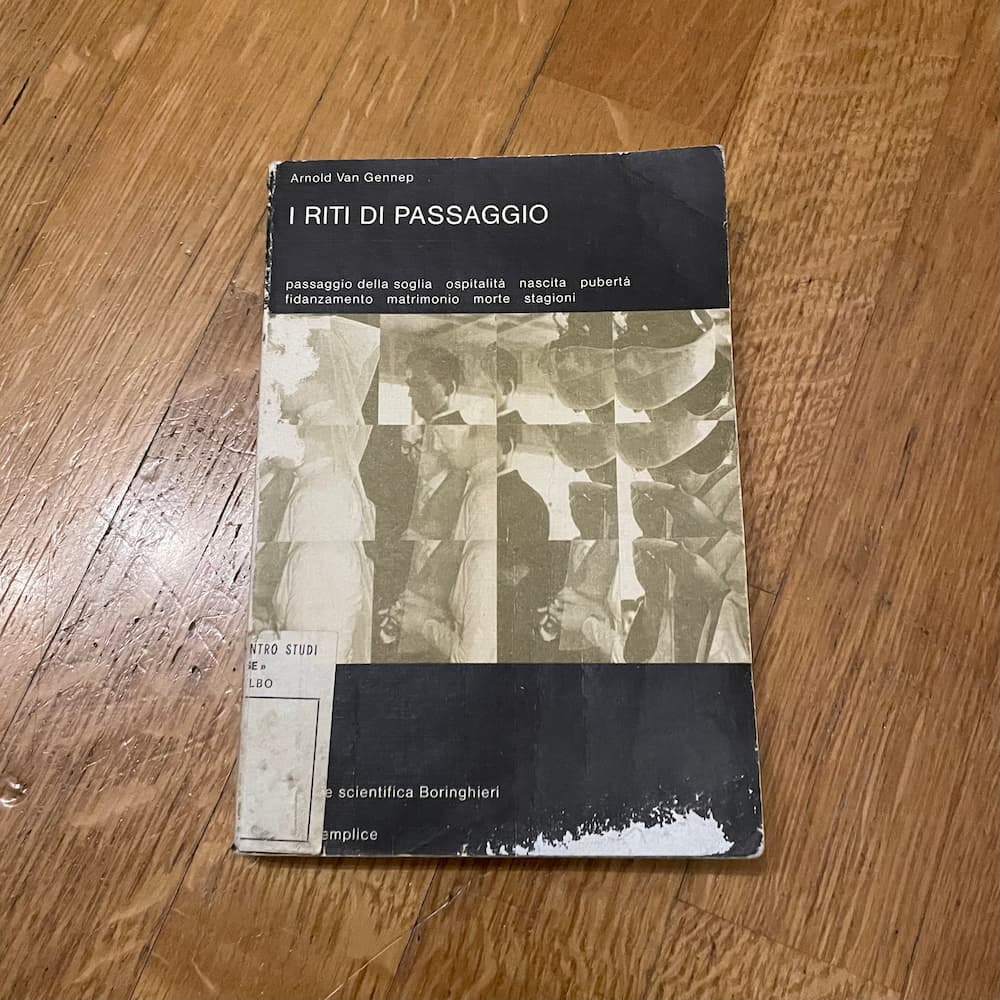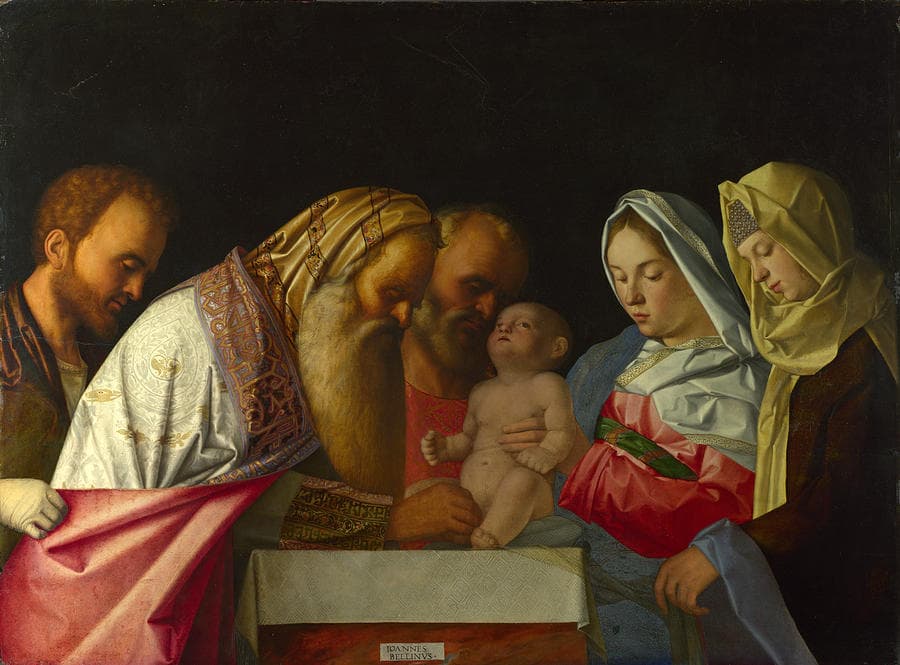Flea Markets = Source of Treasures #
A few weeks ago, at the local flea market, I was very lucky to find a copy of The Rites of Passage by Arnold Van Gennep. It is an Italian edition from 1960s and it belonged to the library of a nearby village. It shows the signs of time, but for the price (about 1€) I couldn’t really complain! I immediately started studying it and I was glad to find, since the first pages, references to The Golden Bough, which I finished previously!

It may be not in a perfect state, but for me it’s glorious!
I’ll try to (badly) recap some of the most intriguing theories exposed here. Let’s remember that the given examples are general, so similarities can be observed with both our modern society and remote past civilisations around the globe.
First, the life of a human being is a series of stages: childhood, puberty, married life , etc. Also, just as important, throughout life, there are communities which a person belongs to. They can be categorised. The most basic partition is sexual-based: men and women – it’s too well-known that they have never been put on the same level. The other clear separation in everyday actions is based on magical-religious aspects: sacred and profane. It may seem subtle, but the distinction is very used even nowadays.
Similarities can be observed with both our modern society and even remote past civilisations around the globe.
In addition to the previous distinctions, imagine that a civilisation is composed essentially by classes: based on professions, castes, religious associations,… We could find so many examples. Moreover, you can picture the sub-classes that we could find, for example, if we divide them geographically (e.g., local parishes).
IT. IS. A. MESS.
‘I Don’t Belong Here’ – T. Yorke #
Ok, it’s like Monopoly: before starting, we have set many pieces on the table, but it gets easier once the game begins. The golden rule is that an individual cannot be part of different classes1. So, in order to change group, a rite (or ceremony) must take place. That’s the focal point and goal of the book: to understand the sequence and, when possible, the meaning of the rituals that are performed in such occasions.
Another powerful picture is given in the very first pages: societies are like buildings with many rooms, one for each “class”. In the primitive civilisations, the walls of the rooms were thicker, so the communication among them was more difficult. In modern society the walls are thinner, so the distinctions are less pronounced. In other words, less rites are required to change class. Progress, we could say. Very true indeed, if it weren’t for some very archaic remnants part of our inner culture.
As other anthropologists did before, Van Gennep pointed out that similarities could be found in ceremonies dedicated to completely different situations: for instance, weddings, funerals, and coronations of kings. What is a common point among them?

The veil was used for many types of celebrations, not just for weddings. It acted as a protection.
It was common, since Roman times, to cover the spouses with a veil. The modern bride still wears it while she walks towards the altar. Why, though? It is to protect her holiness from the profane world that she comes from. The wedding is a change of state to a higher level, in which the woman will be seen with more attributes. The same goes for a king, which wears a cloak during the enthroning ceremony. And the same principle is valid for death: corpses were often covered in sheets because the place where the soul is headed is sacred – its journey must not be impeded by our “filthy” world.
Separation - Transition - Incorporation #
So, if the rites of passage are the ones required to pass from a class to another (or even from a world to a distinct one), this three-step sequence is their key:
- Separation rites (from the previous reality)
- Transition rites
- Incorporation rites (to the new reality)
It may seem absurd to force such classification for all the ceremonies, but the results of Van Gennep’s analysis are quite stunning.
One very important concept is the threshold. Our home’s door, for example: it protects us from the outside world. In the past, both Arabs and Jews stroked an effigy or a casket near the door when entering or exiting the house – an incorporation or separation gesture, depending on the case. Also, in some parts of the world, pregnant women can’t enter through the main door of their houses2. Even bodies, in funeral rites, are not let pass through the main door because it is seen as a bad omen.
Another great example of this concept, often underrated, is the triumphal arch: in Roman times, armies and important personalities passed under the arch to enter symbolically and physically into the new reality and to “wash away” the contamination of the outside3. The simplest threshold can be seen as a barrier between worlds: among many civilisations, it is spread the belief that spirits cannot cross water courses, which in this case act like some other type of boundaries.

In ancient times, swimmers used to mock spirits that couldn’t follow them into the water.
‘Is He Dead?’ ‘No, It’s Just Puberty’ #
Other similarities between rituals related to different moments in life can be observed analysing the initiation rites for special societies or, simply, just the ones for puberty. In a few words, the initiated boy temporarily dies to exit his previous state and enter the new one (adulthood). The example is clearer in Congo, for instance, where the kid was exiled (separation) and painted white, which is a color often related to death (margin). Other than that, when he was re-admitted in his village, he had to act like a baby for weeks, or months: adults had to teach him again the basic tasks, and he also ate baby food (incorporation).
The book is intriguing because there are many other cases illustrated and explained. One for all: circumcision. Why is it performed, and why at different ages (some cultures do it after a few weeks from birth, others after ten years)? Simple answer: it is a way to show the membership to a special class, or society. Quoting the text:
The mutilated individual is removed from the common mass of humanity by a rite of separation (this is the idea behind cutting, piercing, etc.) which automatically incorporates him into a defined group.

“Circumcision of Christ” by Giovanni Bellini. We’re with you, little fella.
Finally, probably the most obvious rite to assign a newborn to a “category”, even unintentionally, is by giving him or her a name. It’s not about using a middle name, as nowadays. In the past, a child could change name several times: first, it was named according to the sex with a generic one; then, an ancestor’s name was chosen; later, depending on the “phase”, or his age, he could change it again. In totemic societies, at the time of initiation, the name could vary once more. And even when a man becomes father, it could be changed again with his son’s.
To conclude the overview of this amazing book, which is such dense of notions yet brief, it is a must for me to spread the word that it is available for free on the Internet Archive!
-
Of course there are exceptions. It is just a rule to simplify the understanding. ↩︎
-
Nursing mothers and pregnant women have always been treated as “special”, but not always in a good way. ↩︎
-
Interestingly, Norse people had a similar tradition and divided their world between inside (Innangard) and outside (Utangard), and the village walls (gardr) were very important. We’ll talk about that. ↩︎